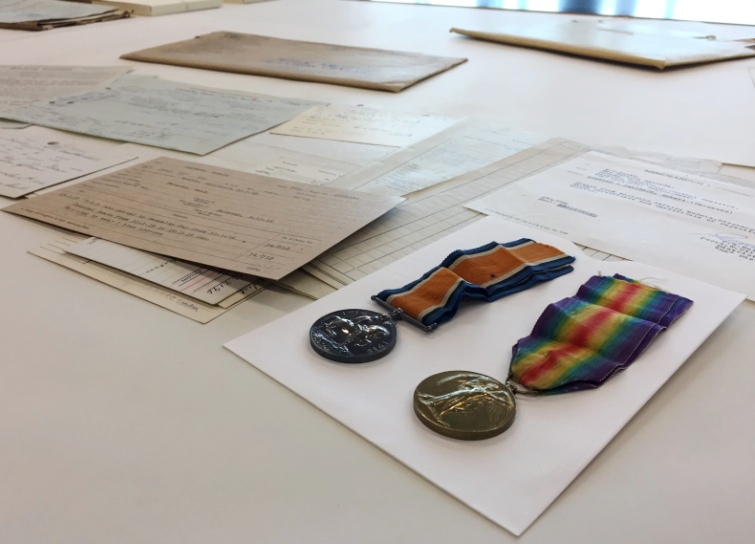Wondering where and when your great-grandfather enlisted to fight in the First World War?

Or maybe what kind of injuries your grandmother treated near the front lines?
Thanks to an ambitious project being carried out at Library and Archives Canada, the answer may be only a few clicks away.
READ MORE: A portrait of soldier Herbert Hayes
Of the 642,000 personnel files stored in row upon row of boxes at the national archives preservation centre in Gatineau, QC, over half (56 per cent) have been uploaded to the web and are searchable online.
It’s been a massive undertaking for the 40 or so staff members devoted to the Canadian Expeditionary Forces Project, which coincides with the centenary of the Great War.
They began in 2013 and, as of this month, they have scanned, filed and uploaded almost 16 million pages of records.
“(Library and Archives) decided to do this project mainly because it’s the most consulted and most requested files that we have in our collection,” said Sophie Dazé, manager of digitization projects at Library and Archives.
READ MORE: Are the Liberals living up to their promises to veterans?
“A lot of people do genealogy research … but not everybody can come to the capital region to actually consult these files. It’s a perfect way to share this knowledge.”
The papers themselves tell the individual story of each solider through their enlistment papers, medical histories, discharge certificates, marriage records, enlistment forms and even the occasional drawing or photograph.
Some files have contained hand-drawn doodles or service medals, and one even had a piece of shrapnel pulled from a solider’s leg.
With Remembrance Day upon us, the manager of the project says he hopes all Canadians will take the time to peruse the files already up online.
“I think that sometimes we just need to stop and reflect on what actually happened in the past, for us to be able to live like we are,” said Jason Roy.
“I’m hoping people take the time to go look through (the documents), even if they can’t find an ancestor who was a part of this, just to go see what they went through. It’s very humbling at times.”
Approximately 61,000 Canadians died fighting in the First World War , which stretched from 1914 to 1918.
A delicate process
The team of archivists working on the digitization follow a precise series of steps to get the documents online.
The contents of each file folder — containing an average of 25 pages — are first sorted by hand into three piles: one containing papers that are undamaged, another for those that show some wear and tear, and the third for documents that are oversized or awkwardly shaped.
Oh, and all the staples need to come out, too.
Each pile is then run through a different scanner. Technicians use a high-speed scanner for the undamaged papers, a manually-loaded one for the papers that need to be handled carefully, and an extra-large scanner for the big sheets.
Each file has already been assigned a bar-code, to make sure all the contents can be re-assembled after the scans are done.
Then the images are compressed into PDF format and uploaded to the Library and Archives website. The originals go back into their cardboard boxes and back into the temperature-controlled vaults.
The process from box to website takes about a month to complete, and each file is checked three times over to make sure nothing gets lost or improperly scanned.
Canadian archives among best in world
Canada probably has the best collection of records from the First World War, noted Marcelle Cinq-Mars, senior military archivist with the department.
That’s because many records from the conflict kept by countries like England, France and Germany were destroyed a few decades later during the Second World War.
READ MORE: Justin Trudeau to reopen Veterans Affairs office in Nova Scotia
The team working on the digitization project has seen some amazing things, including files for some of the 3,000 Canadian women who served in the army medical corps.
A few soldiers had amassed more than 10 “attestation papers,” noted project manager Roy.
“The attestation paper is the very first page that any soldier will fill out,” he explained.
“We often come across (a file) where the soldier was refused due to a medical reason, and they basically hop town and go to the next station to try and get the doctor to say they’re fit to go to war. It’s interesting that these individuals really just wanted to go fight for their country.”
The team is now plowing through the last names beginning with “M,” with an average of 17,000 new names going up online each month.
The “S” boxes are expected to be a challenge, noted Dazé. The “Smiths” alone take up 126 boxes containing 6,925 files.
- Life in the forest: How Stanley Park’s longest resident survived a changing landscape
- ‘They knew’: Victims of sexual abuse by Ontario youth leader sue Anglican Church
- Carbon rebate labelling in bank deposits fuelling confusion, minister says
- Buzz kill? Gen Z less interested in coffee than older Canadians, survey shows











Comments